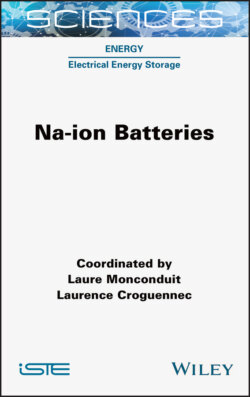Читать книгу Na-ion Batteries - Laure Monconduit - Страница 31
1.3.2.1. O3-Na[Fe,M]O2
ОглавлениеElectrochemical properties of iron-based multiple transition metal oxides in a Na cell were first reported by Okada and colleagues (2006). They compared electrochemical properties of O3-NaFeO2, NaFe1/2Ni1/2O2 and NaNi1/2Ti1/2O2 in Na cells (Okada et al. 2006). O3-NaFe1/2Ni1/2O2 delivers a relatively larger reversible capacity of ca. 110 mAh g−1 corresponding to 0.4 Na extraction from NaFe1/2Ni1/2O2 in the voltage range of 2.0–3.8 V (Wang et al. 2014) compared to ca. 80 mAh g−1 for O3-NaFeO2 (Yabuuchi et al. 2012b). Electronic states of Fe and Ni in O3-NaFe1/2Ni1/2O2 are high spin (HS) Fe3+ (t2g3eg2) and LS Ni3+ (t2g6eg1) configurations respectively. Vassilaras et al. revealed by density functional theory (DFT) calculations and Electron Energy Loss Spectroscopy (EELS) that Fe3+ oxidation is responsible for most of the electrochemical charging reaction in 2.0–3.9 V versus Na with also a partial oxidation of Ni3+ (Vassilaras et al. 2017). Overcharge from 3.9 to 4.2 V results in an irreversible structural change and severe capacity fade. It indicates irreversible Fe-migration from the slab into interslab space for the desodiated NaxFe1/2Ni1/2O2 (x < 0.5). More severe capacity fade is observed for O3-Na[Fe,Ti]O2; actually, O3-Na0.80Fe0.80Ti0.20O2 delivers a reversible capacity of ca. 20 mAh g−1 with two distinct plateaus at 4.0 V on charge and at 2.0 V on discharge in the voltage range of 1.5–4.1 V (Thorne et al. 2014a). The obvious voltage hysteresis is also observed for O3-NaFeO2 and indicates irreversible migration of Fe into the Na layer. Coexistence with Ti4+ or Ni3+ is worse for Fe3+ in O3-Nax[Fe,M]O2 and facilitates the irreversible structural change and Fe migration during the charging process.
Na[Fe,Mn]O2 is one of the most attractive materials because of the elemental abundance of Fe and Mn in the Earth’s crust (Rudnick and Gao 2014). Also, our group reported electrode performance of O3-NaFe1/2Mn1/2O2 in a Na cell in 2012 (Yabuuchi et al. 2012a). Electronic states of Fe and Mn in O3-NaFe1/2Mn1/2O2 are HS Fe3+ (t2g3eg2) and HS Mn3+ (t2g3eg1) configurations respectively. O3-NaFe1/2Mn1/2O2 delivers a reversible capacity of 170 mAh g−1 based on Mn3+/4+ redox in a low-voltage region and Fe3+/4+ in a high-voltage region in the voltage range of 1.5–4.0 V (Figure 1.12).
Figure 1.12. Comparison of galvanostatic charge/discharge curves of layered O3 and O’3 type binary and ternary 3d transition metal oxides (left). Morphology of particles for each sample is also compared (right). Reprinted with permission from Kubota et al. (2018b). Copyright 2018, Wiley-VCH
The O3-type phase transitions into P3 and then OP2-like phases upon charge (Yabuuchi et al. 2012a), which is different from those of the end-members of O3-NaFeO2 and O’3-NaMnO2 that show only O3 and O’3 phases during charge–discharge (Kubota et al. 2018b). Partial Mn substitution for Fe in O3-NaFeO2 induces formation of a P3-type phase during charge and Mn-substitution would stabilize a P-type phase as estimated by calculations (Kim et al. 2012b). However, capacity degradation during cycles is not completely suppressed, which would be caused by migration of transition metal ions since the iron content of 50% in O3-NaFe1/2Mn1/2O2 is higher than the critical values of 33%.
